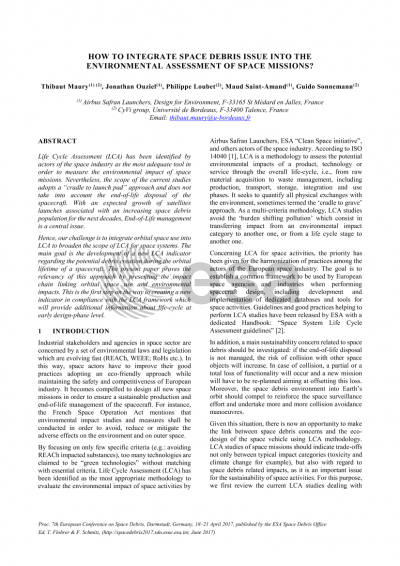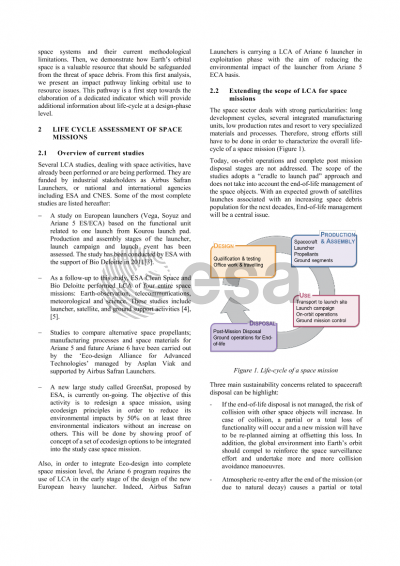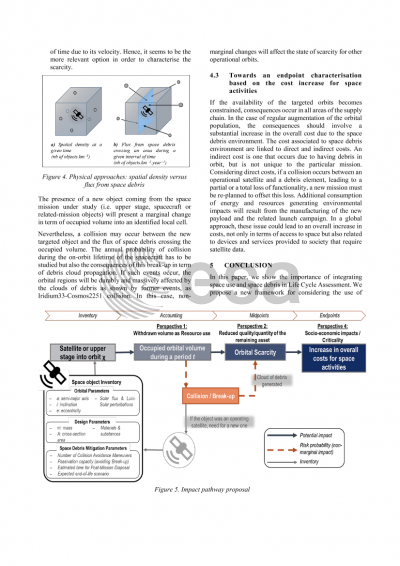Document details

Abstract
Life Cycle Assessment (LCA) has been identified by ESA “Clean Space initiative", Airbus Safran Launchers and others actors of the space industry as the most adequate tool in order to measure the environmental impact of spacecraft missions. The goal is to establish a common framework to be used by European space agencies and industry when performing spacecraft design, including dedicated databases and tools for space activities.
LCA studies dealing with space missions have already been performed by ESA and space industry focusing for example on the European family of launchers, complete space missions or specific materials, propellants and processes. While the space industry produces a much smaller amount of products in comparison to other industries, it is necessary to study its environmental impacts since very specific materials and processes are used combined with very long development cycles. In addition, rocket launches are the only human activity that cross all segments of the atmosphere, including the middle and upper stratosphere.
Nevertheless, the current scope of the studies adopts a “cradle to launch pad” approach and does not take into account the end-of-life disposal of the spacecraft. With an expected growth of satellites launches associated with an increasing space debris population for the next decades, End-of-life management will be a central issue. Three main sustainability concerns related to spacecraft disposal can be highlight:
- If the end-of-life disposal is not managed, the risk of collision with other space objects will increase. In case of collision, a partial or a total loss of functionality will occur and a new mission will have to be re-planned aiming at offsetting this loss. In addition, the global environment into Earth’s orbits should compel to reinforce the space surveillance effort and undertake more and more collision avoidance manoeuvres.
- Atmospheric re-entry after the end of the mission (or due to natural decay) causes a partial or total demiseability of materials due to combustion and sublimation. The environmental impacts induced by the re-entry into the high atmosphere are not addressed today and need further developments.
- The remaining parts of the spacecraft fall down on-ground or into oceans. Local impacts on ecosystem is not well understood and need also to be investigated in terms of hazardous pollutants emissions.
Via the internal R&T project « Eco-space » dealing with eco-design and Life Cycle Assessment, Airbus Safran Launcher is carrying out a large project in partnership with the CyVi group of the University of Bordeaux. Their common work attempts to improve the consideration of these environmental concerns into the traditional LCA methods aiming at covering the overall Life Cycle.
The priority has been given to the integration of space debris related impacts during on-orbit life and End-of-Life Disposal within the LCA framework. Indeed, LCA studies of space missions should indicate trade-offs not only between typical impact categories (toxicity and climate change for example), but also with regard to space debris related impacts, as it is an important issue for the sustainability of space activities. The main goal is the development of a new Life Cycle Impact Assessment (LCIA) indicator regarding the potential debris creation during the orbital lifetime of a spacecraft.
A specificity when dealing with on-orbit space objects is the fact that the outer space near earth is not included as such in the ecosphere, which complicates the perception of environmental impact of spacecraft on their end-of-life. However, considering generation of debris in operating orbits with a ‘Resource depletion’ perspective allows us to address the environmental footprint of the spacraft’s disposal. Volume occupation by debris and dead spacecraft leads to a decrease of the orbital resource availability enhancing the risk of collision and then propagation of new clouds of debris. The lack of access to this resource in the future (scarcity) could be handled as environmental and socio-economic impacts.
The present paper proves the relevancy of this approach by presenting the direct impact chain linking space debris presence within operational orbits and environmental impacts. This is the first step on the way to creating a new indicator in compliance with the LCA framework. Environmental mechanisms (midpoint) and damages (endpoint) will be presented with associated specific characterization factors.
In this way, Airbus Safran Launchers is committed to the ESA Clean Space Initiative and contributes to the big challenge for space industry: keeping the competitive advantage for Europe and decreasing the environmental footprint on Earth and Space.
Preview







